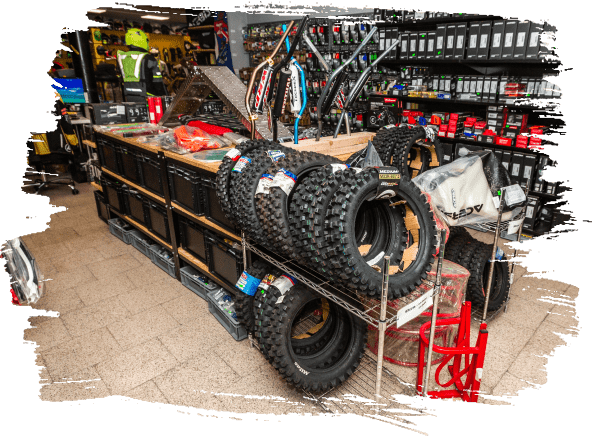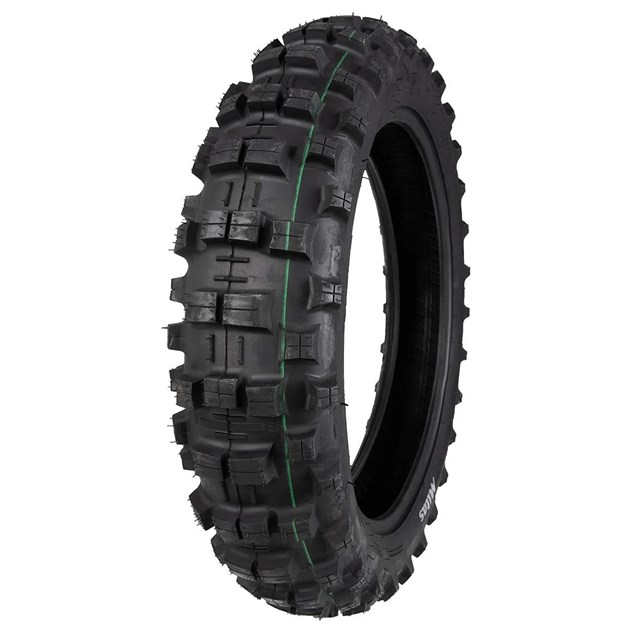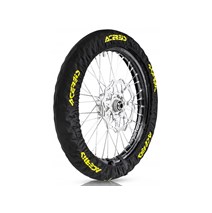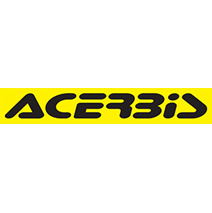MITAS 140/80-18 Terra Force Super Light
Supplier/manufacturer details
Name: Continental Barum s.r.o.
Address:
Otrokovice
76502
Česká republika
The Mitas TERRA FORCE-EF Super Light is an FIM-compliant enduro tyre developed in collaboration with top enduro racers. The right choice for demanding Show all
Not in stock
Fitting and removing tyres can be dangerous and should only be carried out by trained and qualified personnel using the correct tools and working procedures. Failure to follow these procedures may result in incorrect fitting of the tyre to the rim and subsequently cause the tyre to be destroyed with explosive force, which can cause serious injury or death. Make sure the rim, tire and tube are compatible. Check that the tyre is suitable for the equipment/machine. Use only rims recommended or approved by the tire manufacturer. Always use only the correct special equipment and tools. The rim must be clean and in perfect condition (not damaged etc.), if necessary clean the rim with sandpaper. Under no circumstances mount tyres on rims that are cracked, seriously deformed, have welding repair marks, etc. Carefully inspect the inside as well as the outside of the tyre to identify any damage. If the extent of the damage does not allow repair, the tyre should be devalued. If mounting with a tube, always use the correct new tube and liner for the size. For mounting tubeless tires, on tubeless rims, always use a new tubeless valve.Lubricate the rim and bead before mounting. Use only a suitable lubricant that will not destroy the tire (never use silicone or gasoline based lubricants). Vertical mounting is recommended. In the case of horizontal mounting, it is essential to check that the bottom bead is seated correctly. Fit the casing onto the rim opposite the valve hole (respect the direction of rotation indicated by the arrows). Using the mounting lever, gradually slide the first bead over the rim rim rim rim. Then insert a lightly inflated inner tube, sufficiently treated with a slip joint (if fitted), into the rim. Position the valve and secure it lightly with the retaining ring. Fit the second foot, working in sequence so that you end up at the valve. Remove the valve liner to seat and center the shell properly. Slowly inflate and check for proper seating of the casing foot. Ensure that the casing foot has not pinched the inner tube.Maintain a safe distance during inflation, always use a safety cage, preferably attached to a wall or safety chain. During pressure readings, make sure that no part of your body is in the possible trajectory of the valve internals or its cap. It is recommended to use a suitable device to limit the inflation pressure. Use a filter and dehumidifier for the compressed air necessary to remove moisture and dust. If the feet are not seated properly, bleed, re-prime and re-inflate. Repeat this operation until the feet are seated correctly. If all previous operations have been performed correctly, replace the valve liner. Inflate the tyre according to the load. Ensure that the valve does not touch the rim, brake drums or other mechanical parts. Disassembly Never attempt to remove the bead of an inflated tyre. Always remove the valve inner liner. Check that the tyre is completely free of air before dismounting. Never use tools that may damage the rim or tire beads.

Our Store
Not far from Strakonice, in the small village of Jinín next to the world-famous motocross track, you will find our MEFO store. Here, you will always be greeted by friendly salespeople who will be at your disposal throughout your entire shopping experience.

 PLASTICS
PLASTICS airbox and airbox covers
airbox and airbox covers NUMBER PLATE
NUMBER PLATE LOVER FORK COVERS
LOVER FORK COVERS INGNITION & CLUTCH COVER
INGNITION & CLUTCH COVER TANK COVER
TANK COVER MUD FLAP
MUD FLAP SKID PLATES
SKID PLATES FRAME PROTECTOR
FRAME PROTECTOR HEADLIGHT MASK
HEADLIGHT MASK SIDE PANELS
SIDE PANELS TAIL LIGHT FENDER
TAIL LIGHT FENDER FRONT FENDER
FRONT FENDER RADIATOR SCOOPS
RADIATOR SCOOPS REAR FENDER
REAR FENDER UNIVERSAL FENDER
UNIVERSAL FENDER BRAKES
BRAKES BRAKE DISCS & BOLTS
BRAKE DISCS & BOLTS BRAKE PADS
BRAKE PADS CALIPERS & BRAKE PUMPS
CALIPERS & BRAKE PUMPS BRAKE PEDAL
BRAKE PEDAL BRAKE HOSE
BRAKE HOSE DISC COVER
DISC COVER ENGINE PARTS
ENGINE PARTS GASKETS & SEALS
GASKETS & SEALS CARBURETOR
CARBURETOR BEARINGS
BEARINGS OIL PLUG
OIL PLUG PISTON SETS
PISTON SETS TIMING CHAINS
TIMING CHAINS CLUTCH & ACCESSORIES
CLUTCH & ACCESSORIES Trysky
Trysky CYLINDER HEAD
CYLINDER HEAD engine covers
engine covers WATER PUMP
WATER PUMP HANDGUARDS
HANDGUARDS  HANDGUARDS
HANDGUARDS HANDGUARD ACCESSORIES
HANDGUARD ACCESSORIES GRIPS
GRIPS THROTTLE TUBE
THROTTLE TUBE GRIP ACCESSORIES
GRIP ACCESSORIES FILTERS
FILTERS AIR FILTER COVER
AIR FILTER COVER OIL FILTER
OIL FILTER NET AIR FILTER
NET AIR FILTER AIR FILTER
AIR FILTER FUEL FILTER
FUEL FILTER RADIATOR
RADIATOR RADIATORS
RADIATORS RADIATOR LOUVERS
RADIATOR LOUVERS RADIATOR BRACES
RADIATOR BRACES RADIATOR HOSES
RADIATOR HOSES WHEELS
WHEELS BEARINGS
BEARINGS SPOKES
SPOKES SPACERS
SPACERS NUTS
NUTS WHEELS & RIMS
WHEELS & RIMS TPS SENSOR COVER
TPS SENSOR COVER SWINGARM & LINKAGE
SWINGARM & LINKAGE LINKAGE KIT
LINKAGE KIT KETTENBLOCK
KETTENBLOCK LINKAGE COVERS
LINKAGE COVERS SWINGARM PROTECTION
SWINGARM PROTECTION CABLES
CABLES TANKS
TANKS ADDITIONAL TANKS
ADDITIONAL TANKS TANK CAPS
TANK CAPS TANK VALVES
TANK VALVES TANK PARTS
TANK PARTS LEVERS AND PERCH
LEVERS AND PERCH SHIFT LEVERS
SHIFT LEVERS SPARK PLUG
SPARK PLUG  STEERING
STEERING HANDLEBARS
HANDLEBARS CLAMPS
CLAMPS STEERING NECK
STEERING NECK CROSSBAR PAD
CROSSBAR PAD HANDLEBAR ACCESORIES
HANDLEBAR ACCESORIES CHAIN SET
CHAIN SET FRONT SPROCKETS
FRONT SPROCKETS SPROCKETS & SCREWS
SPROCKETS & SCREWS CHAINROLLER
CHAINROLLER SPROCKET COVERS
SPROCKET COVERS  ke kolečkům
ke kolečkům CHAIN GUIDES
CHAIN GUIDES BOLT SETS
BOLT SETS SEATS
SEATS SEAT
SEAT SEATFOAM
SEATFOAM SEAT COVER
SEAT COVER FOOTPEGS
FOOTPEGS FOOTPEGS
FOOTPEGS SPRINGS & PINS
SPRINGS & PINS PROTECTORS
PROTECTORS HEADLIGHTS
HEADLIGHTS SHOCK ABSORBERS
SHOCK ABSORBERS SIMERINGS & DUSTERS
SIMERINGS & DUSTERS SET OF BUSHINGS
SET OF BUSHINGS bleeder screw
bleeder screw sleeves for forks
sleeves for forks rear shock sleeves
rear shock sleeves REAR SHOCK ATTACHMENT
REAR SHOCK ATTACHMENT LAUNCH HELPER
LAUNCH HELPER EXHAUST
EXHAUST EXHAUST PROTECTION
EXHAUST PROTECTION COTTON WOOL
COTTON WOOL PLUGS
PLUGS HEAT-RESISTANT FOIL
HEAT-RESISTANT FOIL CONNECTING RUUBBER
CONNECTING RUUBBER SPRINGS
SPRINGS REPAIR KITS
REPAIR KITS SILENTBLOCK
SILENTBLOCK



 HELMETS
HELMETS FULL FACE
FULL FACE FLIP-UP
FLIP-UP ADVENTURE
ADVENTURE OPEN
OPEN JUNIOR
JUNIOR RETRO
RETRO women's
women's ACCESSORIES
ACCESSORIES GOGGLES
GOGGLES GLASS, TEARS OFF...
GLASS, TEARS OFF... PROTECTION
PROTECTION CHEST PROTECTORS
CHEST PROTECTORS NECK BRACES
NECK BRACES KIDNEY BELTS
KIDNEY BELTS ELBOW PROTECTORS
ELBOW PROTECTORS KNEE GUARDS
KNEE GUARDS BACKBONE
BACKBONE BODY ARMOUR
BODY ARMOUR JUNIOR
JUNIOR BOOTS
BOOTS travel
travel ANKLE
ANKLE ENDURO
ENDURO JUNIOR
JUNIOR soles and more
soles and more Boots
Boots on a scooter
on a scooter JERSEYS
JERSEYS JUNIOR
JUNIOR JACKETS
JACKETS ENDURO
ENDURO women
women REFLECTIVE
REFLECTIVE PANTS
PANTS ENDURO
ENDURO TEXTILIE
TEXTILIE  jeans
jeans summer
summer GLOVES
GLOVES WINTER
WINTER ENDURO
ENDURO summer
summer WATERPROOF
WATERPROOF vložky do rukavic
vložky do rukavic SOCKS
SOCKS WATERPOOF GEAR
WATERPOOF GEAR VESTS
VESTS Accessories for bikers
Accessories for bikers HOODS
HOODS SCARF
SCARF belts
belts drobnosti
drobnosti THERMO UNDERWEAR
THERMO UNDERWEAR THERMO T-SHIRTS
THERMO T-SHIRTS THERMO PANTS
THERMO PANTS THERMO KNEE SOCKS
THERMO KNEE SOCKS leisurewear
leisurewear leisure jackets
leisure jackets leisure trousers
leisure trousers T-SHIRTS
T-SHIRTS trika-uni
trika-uni Children's T-shirts
Children's T-shirts Mini T-shirts
Mini T-shirts Sweatpants
Sweatpants Headwear
Headwear HAT
HAT SWEATSHIRT
SWEATSHIRT shorts
shorts friee time
friee time SOFT PANTS
SOFT PANTS MEFO MOUSSE
MEFO MOUSSE MOUSSE GEL
MOUSSE GEL MOUSSE KIT
MOUSSE KIT 10"
10" 12"
12" 14"
14" 16"
16" 17"
17" 18"
18" 19"
19" 20"
20" 21"
21" TUBE
TUBE 4"
4" 5"
5" 6"
6" 8"
8" 9"
9" 10"
10" 12"
12" 13"
13" 14"
14" 15"
15" 16"
16" 17"
17" 18"
18" 19"
19" 21"
21" 22"
22" 23"
23" HALTERS
HALTERS MX TIRE
MX TIRE 10"
10" 12"
12" 14"
14" 15"
15" 16"
16" 17"
17" 18"
18" 19"
19" 20"
20" 21"
21" ENDURO TIRE
ENDURO TIRE ROAD TIRE
ROAD TIRE 15"
15" 23"
23" 4"-6,5"
4"-6,5" 8"
8" 13"
13" TOOLS
TOOLS Wrenches, hooks, screwdrivers
Wrenches, hooks, screwdrivers TIRE LEVERS
TIRE LEVERS  CHAIN BREAKERS
CHAIN BREAKERS Preparations for shocks
Preparations for shocks Preparations for wheels
Preparations for wheels Engine preparations
Engine preparations Preparations for bearings
Preparations for bearings OTHER MOTO TOOLS
OTHER MOTO TOOLS GRAPHICKITS, NUMBERS
GRAPHICKITS, NUMBERS Canisters, measuring cups
Canisters, measuring cups TRANSPORT
TRANSPORT CARPETS
CARPETS MOTORCYCLE COVERS
MOTORCYCLE COVERS HOURMETER
HOURMETER helpers for track and training
helpers for track and training STAND
STAND HYDRATION BAGS
HYDRATION BAGS PIT BOARD, MARKER
PIT BOARD, MARKER MOTO LUGGAGE
MOTO LUGGAGE BACKPACKS
BACKPACKS WAIST PACKS
WAIST PACKS FORK OIL
FORK OIL AIR FILTER OIL
AIR FILTER OIL CHAIN LUBES
CHAIN LUBES COOLANT FLUID
COOLANT FLUID BRAKE FLUID
BRAKE FLUID CLEANER AND IMPREGNATION
CLEANER AND IMPREGNATION additives
additives VOUCHERS
VOUCHERS KEYCHAINS
KEYCHAINS WRISTBANDS
WRISTBANDS STAND
STAND PLATE
PLATE BOOK
BOOK WEAR SALE
WEAR SALE HELMETS SALE
HELMETS SALE dresy a kalhoty
dresy a kalhoty doplňky
doplňky LEVERS SALE
LEVERS SALE







